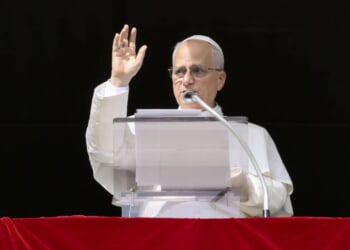Unusually, the Terminal High Altitude Area Defense (THAAD) missile does not have an explosive warhead. Instead, it takes down incoming projectiles by colliding directly with them.
The Terminal High Altitude Area Defense system, or THAAD, is one of the most advanced missile defense platforms ever built—a mobile, high-altitude shield designed to intercept and destroy ballistic missiles during the final seconds of their flight.
Developed by Lockheed Martin for the US Army, THAAD represents the top tier of regional missile defense, offering a vital layer between short-range interceptors, like the Patriot, and global systems, like the Ground-Based Midcourse Defense. It makes up the backbone of America’s air defense—and is certain to play a major role in President Donald Trump’s envisioned “Golden Dome” air defense shield, if that project comes to fruition.
How the THAAD Air Defense System Works
At its heart, THAAD employs a very simple concept: to destroy an incoming warhead by hitting it directly at extreme speed. Unlike other missile interceptors—such as the larger and more sophisticated Ground-Based Interceptor (GBI), recently featured in the film A House of Dynamite—THAAD missiles do not rely on a midair detonation or explosion to shoot down incoming missiles. Instead, they are designed to take down the incoming projectile by striking it head-on, an approach known as “hit-to-kill.”
When a ballistic missile reenters the atmosphere on a high-velocity trajectory, THAAD launches an interceptor that collides with the incoming missile head-on, releasing enough kinetic energy to destroy the target. Because THAAD missiles do not use warheads of their own, they bypass the risk of inadvertently detonating a nuclear or chemical payload midair, making them somewhat cleaner and safer than other interceptor systems.
THAAD’s technical components can be broken down into four main parts: the interceptor missiles, the AN/TPY-2 radar, a fire control and communications unit, and launcher vehicles. The THAAD relies on a high-powered X-band radar capable of detecting and tracking incoming missiles hundreds of kilometers away. Once a threat is identified, the fire control center calculates a projected intercept point and cues one or more THAAD launchers (each truck carries up to eight missiles standing by). The interceptor is a single-stage, solid-fuel rocket equipped with advanced guidance and an infrared sewer that homes in on the target in the final seconds of flight; it can engage threats at altitudes up to roughly 150 kilometers (which is nearly at the edge of space) and at ranges of about 200 kilometers while traveling at speeds above Mach 8.
The THAAD System Fills a Critical Gap in America’s Air Defenses
The THAAD engagement envelope is high enough to intercept missiles both inside and outside the atmosphere—making the system ideal as a mid-tier layer in a comprehensive defense network. Below the THAAD is the Patriot system, protecting lower altitudes and shorter ranges; above the THAAD is the Aegis Ballistic Missile Defense and the Ground-Based Midcourse System, providing long-range, eco-atmospheric coverage. When all these systems are combined, the US enjoys a layered shield of defense, with multiple opportunities to detect, track, and intercept ballistic threats before impact.
THAAD’s mobility due to its truck mounting has allowed the United States to rapidly reinforce its allies or forward bases without the need for permanent infrastructure. In the past, THAAD deployments to Guam, South Korea, and the United Arab Emirates have operated not purely as defense tactics, but also as a deterrent, forcing an adversary to account for US-linked interceptors. Simultaneously, THAAD operates as a diplomatic instrument, allowing allies—recently including Japan, Israel, and Saudi Arabia—to feel the symbolism, and practicality, of being directly integrating within the preemptively stabilizing US defensive scheme.
About the Author: Harrison Kass
Harrison Kass is a senior defense and national security writer at The National Interest. Kass is an attorney and former political candidate who joined the US Air Force as a pilot trainee before being medically discharged. He focuses on military strategy, aerospace, and global security affairs. He holds a JD from the University of Oregon and a master’s in Global Journalism and International Relations from NYU.
Image: Wikimedia Commons.
















